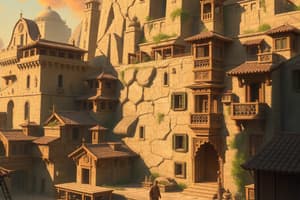Podcast
Questions and Answers
What type of dwelling is characterized by being made from natural formations and providing basic protection against elements?
What type of dwelling is characterized by being made from natural formations and providing basic protection against elements?
- Cave Dwellings (correct)
- Ephemeral Dwellings
- Periodic Dwellings
- Lean-To Shelter
Which characteristic is NOT associated with ephemeral dwellings?
Which characteristic is NOT associated with ephemeral dwellings?
- Constructed by mobile societies
- Built for temporary use
- Dependent on hunting and gathering economies
- Allows for extended habitation (correct)
Which of the following is an example of periodic dwelling?
Which of the following is an example of periodic dwelling?
- Chum
- Yurt (correct)
- Igloo
- Tabon Cave
What describes the purpose of a chum in traditional societies?
What describes the purpose of a chum in traditional societies?
Which statement about the Inuit igloo is correct?
Which statement about the Inuit igloo is correct?
What material is traditionally used for the felt cover of a yurt?
What material is traditionally used for the felt cover of a yurt?
What is a characteristic feature of early hogans?
What is a characteristic feature of early hogans?
What type of societies primarily utilize seasonal dwellings?
What type of societies primarily utilize seasonal dwellings?
What social structure is reflected in the transition to permanent dwellings?
What social structure is reflected in the transition to permanent dwellings?
Which feature is NOT associated with traditional English cottages?
Which feature is NOT associated with traditional English cottages?
Flashcards are hidden until you start studying
Study Notes
Dwellings and their Types
- Natural Formations: Dwellings made from natural formations, such as caves or rock shelters, provide basic protection from the elements.
- Ephemeral Dwellings: Ephemeral dwellings, designed for temporary use, are not characterized by permanence.
- Periodic Dwellings: Examples of periodic dwellings include seasonal shelters used in certain regions or for specific purposes.
- Chum Purpose: Chums, found in traditional societies, serve as communal dwellings and are often used for social gatherings and ceremonies.
- Inuit Igloo: The Inuit igloo, built with snow blocks, provides an insulated and relatively warm environment, particularly suitable for harsh Arctic conditions.
- Yurt Felt Cover: The felt cover of a yurt, traditionally made from wool, provides insulation and protection from weather.
- Early Hogan Feature: A defining characteristic of early hogans, which are Native American dwellings, is their domed shape, often constructed using logs.
- Seasonal Dwellings: Societies that rely on nomadic lifestyles or seasonal migrations often utilize seasonal dwellings adapted to different environments.
- Permanent Dwellings and Social Structure: The transition to permanent dwellings reflects a shift towards more established communities and settled lifestyles, influencing social organization and group dynamics.
- English Cottage Feature: Traditional English cottages are known for their thatched roofs, not necessarily chimneys, though chimneys are often present.
Studying That Suits You
Use AI to generate personalized quizzes and flashcards to suit your learning preferences.




